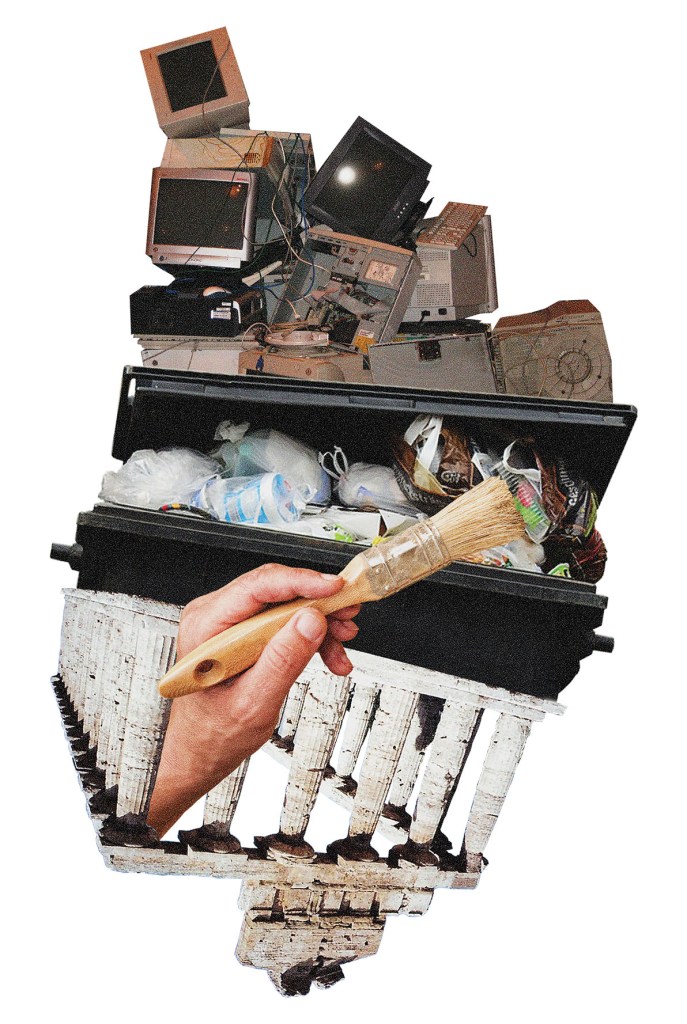This story appears in the September Issue of VICE magazine. Click HERE to subscribe.
What comes to mind when you think about archaeology? Egypt? Bones? High-waisted trousers and chisels? The word “archaeology” comes from the Greek arkhaiologia, which literally means “the study of ancient things.” But in the 1970s, an American archaeologist named William Rathje decided to study his own era’s trash, and a new field emerged: contemporary archaeology.
Videos by VICE
In their 1992 book, Rubbish!: The Archaeology of Garbage, Rathje and co-author Cullen Murphy wrote, “What people have owned—and thrown away—can speak more eloquently, informatively, and truthfully about the lives they lead than they themselves ever may.” They found that humans consumed less fruit and more junk food and alcohol than they said they did. And, counterintuitively, people actually wasted more during economic recession.
Phonebooks, disposable diapers, medicine vials, half-empty cans of paint—this was the stuff of Rathje’s attention. It was no less deserving of it, he argued, than the artifacts placed behind glass in museums. (After all, one could argue that’s just antique trash.)
But while Mayan remnants look like limestone fragments and ceramic vessels, humans of the past century have left behind aluminum, concrete, plastic, and more.
According to a study published in July in Science Advances—the first to analyze all plastic ever manufactured—humans have made 8.3 billion metric tons of the material in total. By 2050, that number is expected to increase by nearly 50 percent. By then, there might be more plastic than fish in the world’s oceans, says a report released earlier this year by the World Economic Forum.
Plastic, which is cheaper and easier to make than glass and ceramics, is ephemeral in function but not in life span—a plastic bag takes at least 500 years to disintegrate. In 2013, scientists found what they called “plastiglomerates”—rocks made from plastic, volcanic rock, sand, shells, and coral—on a beach in Hawaii.
“[The plastiglomerates] might be a nice marker,” geophysicist Douglas Jerolmack told the American Association for the Advancement of Science’s Science magazine in 2014, “of when humans came to dominate the globe and leave behind their refuse in mass quantities.”
And it’s not just pieces of trash that we’re leaving behind: The human species has actually modified the sediment of the earth. According to another article published in Science by a working group of 24 scientists who study the Anthropocene, there is now plastic, radiation, and soot embedded in the actual surface of the planet.
“This is hyper-consuming, hyper-disposing, and discarding that’s happening at a rate that we haven’t seen,” said Courtney Singleton, a PhD student in anthropology at Columbia University, who, like Rathje did, studies modern-age trash. She’s currently focusing on a homeless encampment in the Bronx, where ballpoint pens, bottle caps, Styrofoam scraps, broken toys, film canisters, condoms, tiny vials that once contained crack cocaine, and hairclips provide clues to the lives of the people who have passed through the squat since at least the 1980s.
Instead of carbon dating the objects she finds, Singleton often burns them—the drip, the color of the flame, and the scent that comes off burned plastic can provide clues about the manufacturing process. Alternatively, she googles patent numbers or uploads an image to Facebook to crowdsource an answer as to the era of an item.
“When I have students come in to work… I always feel like they want to be dealing with ancient Egyptian artifacts or Inca stuff!” Singleton said, laughing. “And I’m giving them their own waste to analyze.” But for Singleton, the past is politically present and has implications for now and the future—she’s interested in “the archaeology of five minutes ago.” The past, she added, “BAM! It’s already here.”
When Rathje was digging up landfills in the 80s, there was a pervading fear in the US that there was some kind of garbage crisis and that Styrofoam, in particular, was to blame. It was a myth. Forty percent of the space of the landfills was taken up not by Big Mac wrappers, aluminium cans, or disposable diapers but by paper. Rathje noted this discovery in Rubbish!, and upon its release, a New York Times reporter said it wasn’t surprising “in an information age.”
Fast-forward to 2017, and “information” means HTML, MP3 files, GIFs, or the metadata on that nude you texted in 2003. The legacy of our species is less physical junk like plastic, or even atmospheric deposits (like CO2), but artifacts that have no physicality. A new field of archaeology has emerged to deal with this peculiar refuse: digital archaeology. It remains to be seen what sort of tools will be required for rifling through internet trash.




